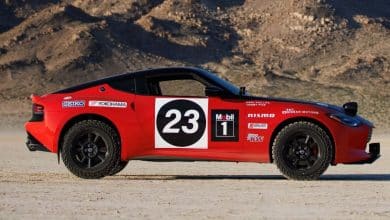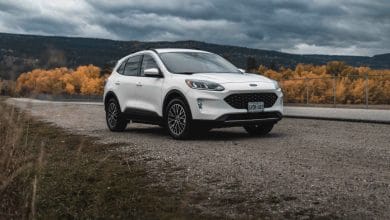
Contents
Design

PHOTO PROVIDED BY HONDA
The presentation of the Honda Pilot Trailsport is largely influenced by a more conventional representation of the SUV, focusing on an elongated hood and set-back front pillars as well as a beefy beltline.
The design of this Pilot is something of a return to basics. Like its first generation launched in 2003, it now focuses on a more cubic and assertive design than the profiled silhouette of the previous vintage. It is a presentation largely influenced by a more conventional representation of the SUV, focusing on an elongated hood and set-back front pillars as well as a beefy beltline. The horizontal grille is also impressive and is complemented by headlights that fit into the broad shoulders of the SUV. The widened front and rear tracks and the slightly extended wheelbase (70 mm) of its new platform also increase this impression of robustness which, again, does not lapse into caricature, in direct line with the family vocation of the model.
On board

PHOTO PROVIDED BY HONDA
The interior of the Honda Pilot
The interior also embraces this desire for normality. The rather neutral shades, bordering on austere, soften a horizontal presentation with a reminder of the grille in the design of the nozzles. The quality of the materials and the finesse of the rendering do not reach the level of a Mazda CX-90, but the assembly remains solid and the practical aspect has almost no equal in the segment. You just have to look at the ingenious design of the storage spaces in the front and rear doors to be convinced. The removable rear console placed between the two seats (an option) also reflects this desire for modularity. These rear seats are also rather comfortable, but the seats remain low, the result of a thick roof. Honda also integrates a clever mechanism that allows access to the third row with the simple press of a button.
Under the hood

PHOTO PROVIDED BY HONDA
The 3.5L V6 produces 285 hp, barely 5 hp more than the previous engine.
Honda has updated the naturally aspirated V6 that has been with the Pilot since its infancy. This 3.5 L engine, however, skips the VTEC system and adopts a more traditional double overhead camshaft configuration without control over the opening of the valves which changed its song at high revs. More uniform in terms of sound, it recalls Honda's immense expertise in this area with a smoothness and progressiveness of power much better than most turbocharged mechanics. Certainly, its torque deficit (262 lb-ft) is more noticeable at low revs and its power of 285 hp does not transform it into a sprinter, but its temperament well guided by a 10-speed transmission makes it a piece of choice that consumes suitably, without however shining in this aspect (10.4 L/100 km in test).
Behind the wheel

PHOTO PROVIDED BY HONDA
Asperities are managed with predictability, limiting secondary shocks.
By means of a platform whose rigidity has been greatly increased, the SUV promises from the outset to be more solid on its four wheels. While such a statement is less striking for a vehicle of its kind, this SUV drives – pardon the pun – quite well. The steering with variable gear ratio and fitted with a stiffer column presents good progressivity. Granted, there's not a lot of feel or firmness, but it limits the need to make slight corrections to stay on course. This cohesion is also palpable in terms of depreciation. Asperities are managed with predictability, limiting secondary shocks. Note also the contribution of the new standard all-wheel drive equipped with a rear differential capable of receiving up to 70% of the torque, making it possible to improve off-road performance.
Embedded technologies

PHOTO PROVIDED BY HONDA
Rather quick in its management of commands, the Honda Pilot's multimedia system has the merit of being equipped with several physical buttons both on the steering wheel, on the central nacelle and near the screen.
This Pilot uses the latest multimedia system offered in all Honda models and which is controlled via a 7 or 9-inch touch screen, depending on the variant. Rather quick in its management of controls, it has the merit of being equipped with several physical buttons both on the steering wheel, on the central nacelle and near the screen. The system itself is easy to approach and has a streamlined interface to limit distractions. The instrumentation mixes digital with a physical needle for the speedometer in certain liveries, while others rely on a fully digital screen of good definition. In terms of safety, all versions are equipped with more efficient active elements thanks to the use of a radar and a front camera with improved fields of vision.
The verdict

PHOTO PROVIDED BY HONDA
The Honda Pilot is a warrior of normality that has refined its recipe once again to aspire to the podium in its category.
During the week spent behind the wheel, this Honda Pilot obviously did not inspire a string of superlatives to describe its attributes. The SUV has rather adapted to the daily routine with dedication thanks to its spacious interior and the undeniable comfort of its furniture and cushioning. Its smoother mechanics than many of the competition's turbocharged four-cylinders deliver its adequate power gradually, but we would obviously have liked the possibility of opting for a hybrid group to reduce its thirst. Its behavior is also very safe, but not as gripping as the Mazda CX-90, making it flexible. A warrior of normality, in short, who has refined his recipe once again to aspire to the podium in his category. It's exactly what a family is looking for, and maybe even more.
Notebook
The Trailsport version for light off-road
If you plan to use your Pilot for light off-roading, the Trailsport livery offers an increase in ground clearance of 22 mm as well as the addition of skid plates and personalized all-wheel drive adjustment.
A rear differential that helps a lot
The new rear differential of this Pilot allows the transfer of 70% of the torque produced by the engine to the rear. Up to 100% of this available torque can subsequently be channeled to one of the two wheels to improve road handling and off-road traction.
This V6 that refuses to die
This 3.5L V6 receives the contribution of a cylinder head with four valves per cylinder for better breathing, in addition to direct injection as well as displacement deactivation for energy efficiency. Its Honda-developed 10-speed transmission can seem hyperactive at times due to its short ratios, but keeps its revs low.
It can tow many objects
With 2268 kg of standard towing capacity, this Pilot can tow many trailers and trailers.
A very competitive cargo volume
With 635 L available behind the third row, a figure which increases to 1685 L when folded, this SUV is one of the best in the segment in this regard.
Technical sheet
- Model tested: Honda Pilot Trailsport
- Engine: 3.5L DOHC V6
- Power: 285 hp at 6100 rpm
- Torque: 262 lb-ft at 5000 rpm
- Transmission: 10-speed automatic with manual mode
- Powertrain architecture: front transverse engine, all-wheel drive
- Consumption (ÉnerGuide): 11.8 L/100 km (Trailsport); 11 L/100 km (other liveries)
- Price (with options, freight and preparation): $58,572 (price range between $51,772 and $63,972)
- Competitors: Chevrolet Traverse, Dodge Durango GMC Acadia, Ford Explorer, Hyundai Palisade, Jeep Grand Cherokee, Kia Telluride, Nissan Pathfinder, Mazda CX-90, Subaru Ascent, Toyota Grand Highlander and Volkswagen Atlas
- Anything new in 2024? No major changes
Visit the Honda website












